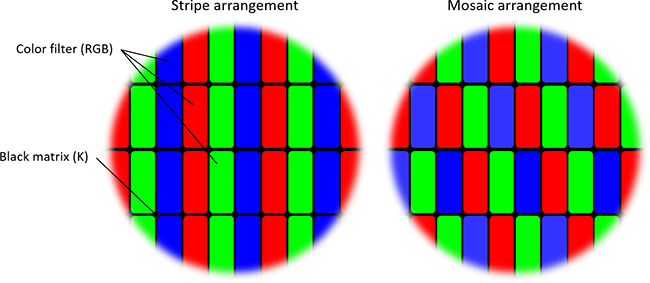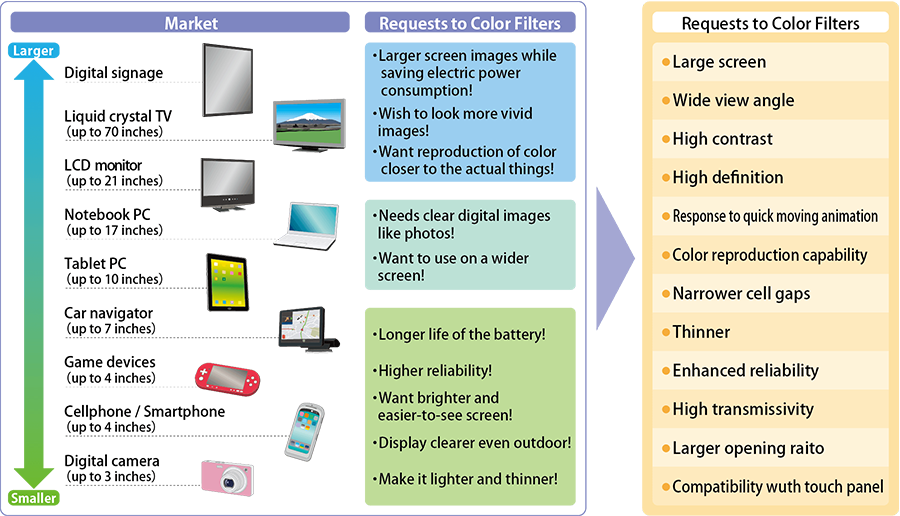Color filter arrays are key components in modern display technology, playing a crucial role in devices such as televisions, computer monitors, and smartphone screens. This article will introduce the basic principles, types, and applications of color filter arrays in modern display technology.

The working principle of color filter arrays is based on the selective absorption and transmission of light wavelengths. Light itself is composed of multiple colors, each corresponding to a certain range of wavelengths. Here are some key points in the working principle of color filter arrays:
1、Wavelength Selectivity: Color filter arrays can selectively absorb or transmit light of specific wavelengths based on their material properties. For example, a red filter only allows red light (wavelengths approximately 620-750 nanometers) to pass through while absorbing other colors of light.
2、Principle of Three Primary Colors: The most common color filter arrays are based on a combination of red, green, and blue. These three colors are the basis of human color perception and can be mixed to produce almost all other colors. By adjusting the relative intensity of these three colored light sources, a wide range of colors can be generated, from black to white and various shades in between.
3、Color Generation in Pixels: On a display screen, each pixel typically contains red, green, and blue sub-pixels. Each sub-pixel has a corresponding color filter, allowing light of the respective color to pass through. By controlling the brightness of each sub-pixel, the display can generate a wide range of colors at each pixel point.

1、RGB Filter Array: This is the most common type of color filter array, consisting of red (R), green (G), and blue (B) filters. Each of these basic color filters only allows light of the corresponding color to pass through. By controlling the combination and intensity of these three colors, a wide range of colors can be produced on the display screen.
2、CMY Filter Array: A less common type, including cyan (Cyan), magenta (Magenta), and yellow (Yellow) filters. This filter system works on the principle of subtractive color mixing, opposite to RGB. CMY filter arrays are typically used in special applications, such as certain types of printing technology where colors are produced by absorbing parts of the spectrum.

Color filter arrays have a wide range of applications. In liquid crystal displays (LCDs) and certain types of organic light-emitting diode (OLED) display technologies, they are the core components for generating colored pixels. Additionally, in photography and video shooting equipment, color filter arrays are used to enhance the saturation and accuracy of image colors. In scientific research and medical imaging, color filter arrays help analyze specific wavelengths of light for diagnosis, experimental observation, and data analysis. With technological advancements, the applications of color filter arrays are continually expanding, for instance, in automotive display systems, aerospace instrumentation, and various sensors.
As an integral part of modern display and imaging technology, the role and importance of color filter arrays cannot be overlooked. With the continuous development of new materials and manufacturing technologies, color filter arrays will continue to drive innovation and progress in display technology, bringing us more accurate and vivid visual experiences.
The 8 inch displays might be affected and delay for an accident.
New iPhone 13 Series will use On-Cell OLED Displays. And it that will be launched in the second half of this year will be exclusively supplied by Samsung Display (SDC)
This is the project management of how sinocrystal handle your customized project relate to displays.
Discover the key factors to consider when choosing an LCD display for your project, including size, resolution, interface, brightness, and customization options from a factory-direct manufacturer.
Discover the latest innovations in rugged LCD displays for harsh environments — from extreme temperature resistance to sunlight readability and waterproof designs. Factory-direct manufacturing with full customization.
A complete guide to LCD display connection methods, including SPI, I2C, RGB, MIPI, LVDS interfaces and physical mounting options. Learn how to connect monochrome and TFT LCDs to your development board or product housing.
This week, we had the pleasure of hosting an esteemed international client at our LCD display manufacturing facility in Dongguan. Guided by our team, the client visited key production areas such as the fully automated COG bonding line, backlight assembly area, full lamination workshop, and final product aging test section. They highly appreciated our production capacity, strict quality control, and engineering expertise. This visit strengthened mutual trust and set the stage for future collabora